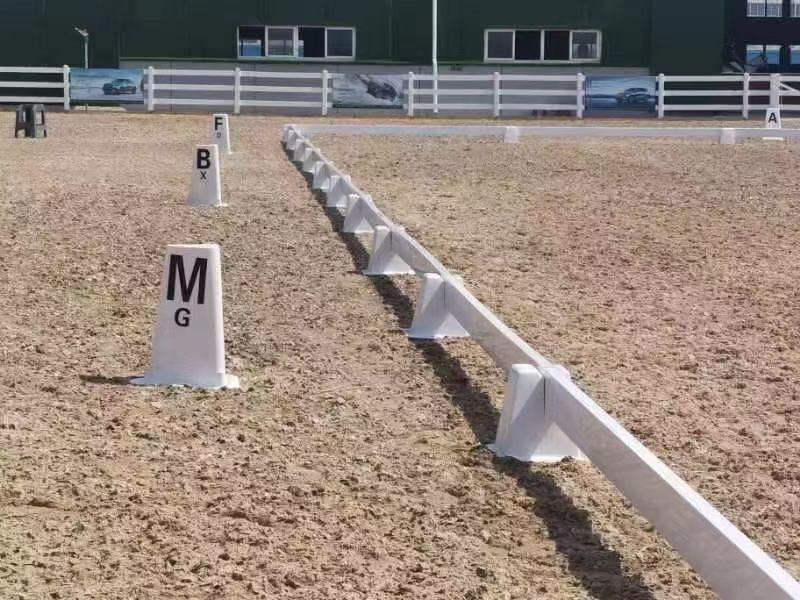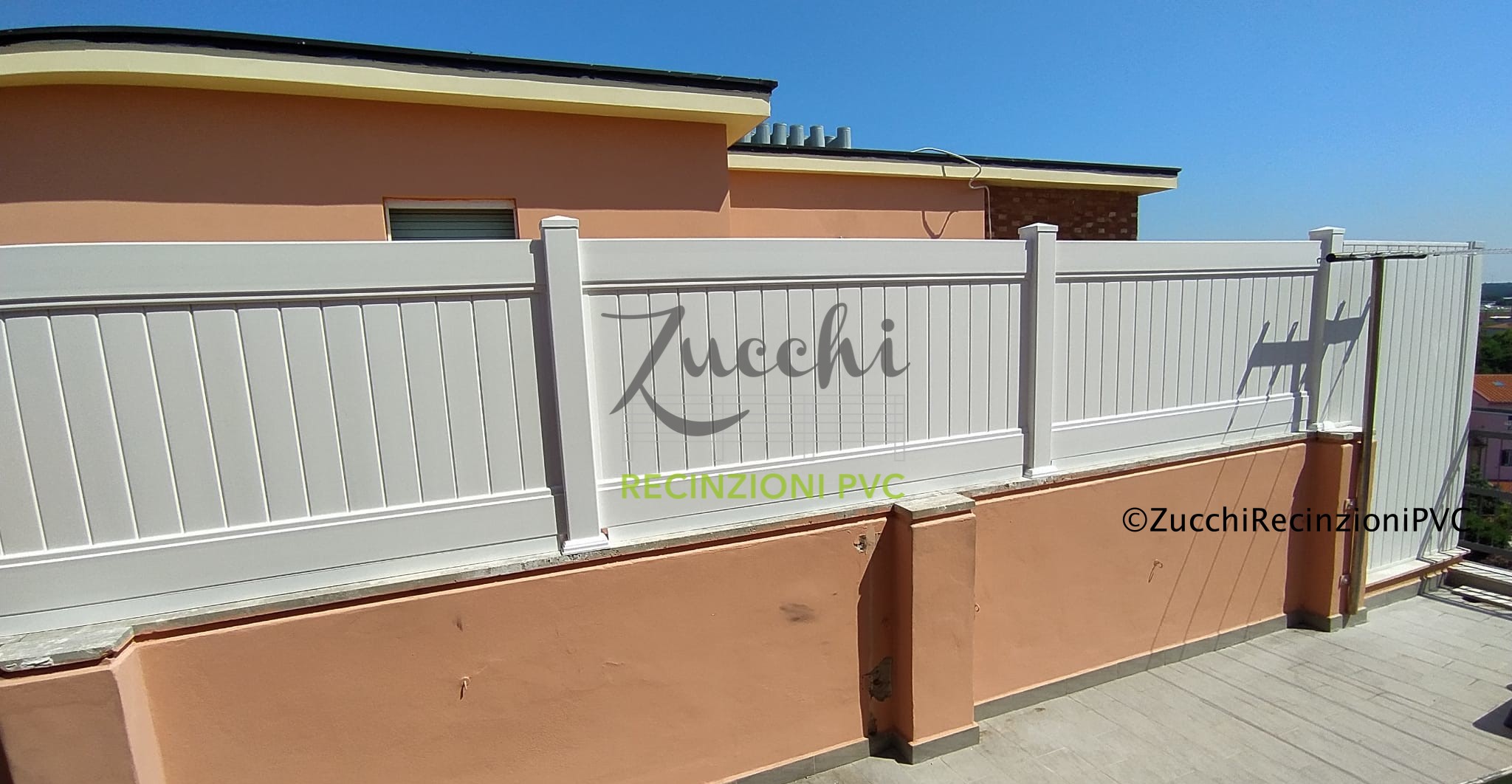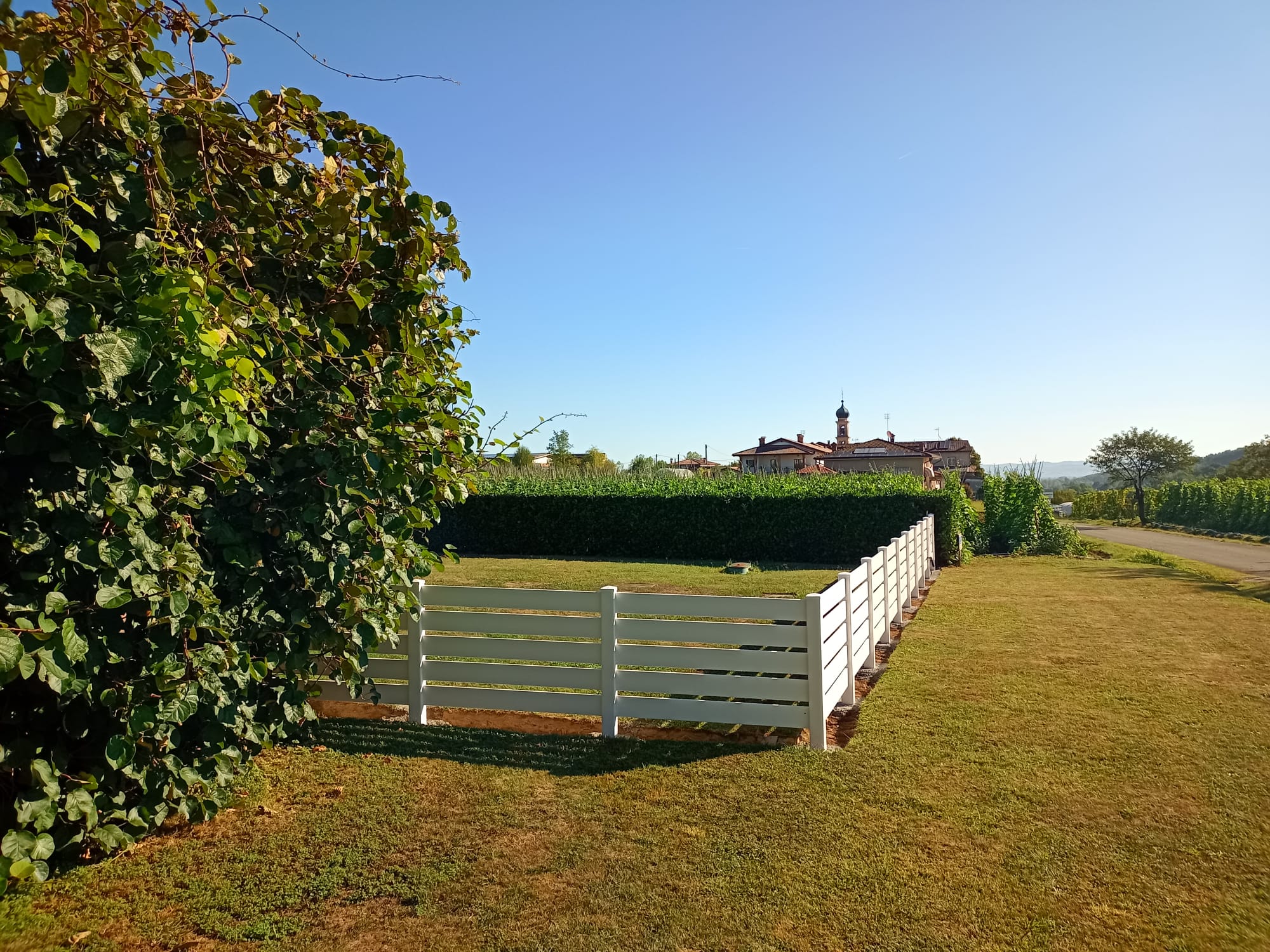Recommended Frequency: When and How to Intervene
Keeping your dressage arena in order is not just a matter of aesthetics, but also of safety and compliance. However, the question often arises: how often should the markers be cleaned? And what exactly should be done to keep them looking nice, white, and properly positioned?
The good news is that you don’t need to become a cleaning fanatic: just a bit of organization and consistent attention will do. In this section, I’ll explain everything step by step to help you avoid common mistakes and keep your PVC dressage arena always ready for training and competitions.
Routine Cleaning: Little and Often Works Best
Forget large seasonal cleanings like spring cleaning: when it comes to PVC markers, the key word is consistency. A quick but regular wipe-down can really make a difference.
I recommend doing a light cleaning every 1–2 weeks, especially if the arena is outdoors and exposed to dust, mud, or rain. During the drier and hotter months, when the sun is strong and dust is everywhere, you may need to increase the frequency to once a week.
The advantage of PVC is that it cleans very easily: just a microfiber cloth, lukewarm water, and a bit of mild detergent. Avoid abrasive products or harsh degreasers, as they can dull the surface over time.
You can also use a soft sponge or a small sprayer for tougher spots, like mud splashes or stains left by hooves. Clean with circular motions and, if you’re in the mood, you can involve your younger students: turning cleaning into an educational activity can be a fun idea.
Deep Cleaning: After Events or Bad Weather
Have you just hosted a competition or has it rained for three days straight? It’s time for a deep cleaning. Don’t worry: it doesn’t mean taking everything apart, just doing a thorough check-up of the dressage arena.
After an event, especially if you had an audience, young horses, or inexperienced riders, some markers are likely to have been moved, scratched, or stepped on. In these cases, it’s a good idea to take about an hour to check the position, condition, and cleanliness of each segment.
Another critical moment is right after heavy rain or particularly windy days. Mud, sand, or leaves can accumulate at the base of the markers, making them less stable and potentially slippery. In these situations, arm yourself with a dustpan, small broom, and bucket, and remove everything that could compromise safety.
Every 2–3 months, you can schedule a deeper cleaning where you disassemble and wash each section of the dressage arena, taking the opportunity to straighten the letters or fix any unevenness in the ground. Alternatively, you can do this seasonally: early spring and late summer are ideal times.
When a Structural Inspection Is Needed
Besides cleaning, don’t forget that a structural inspection of the dressage arena is needed occasionally. PVC is durable, but over time it can still yellow, crack, or lose stability, especially if constantly exposed to sun and impacts.
Every 6 months, I recommend checking each element: look for cracks, chips, deformities, or issues with the base supports. If you notice a section moves too much or is hard to straighten, it might be time to replace it.
The letters can also fade over time, making the arena less readable for judges and riders. In that case, you can simply reprint them, reapply them, or order new ones. These are small details, but they make a big difference in the overall presentation of your facility.
If your center hosts official competitions, remember that FISE may conduct inspections. A well-maintained dressage arena shows professionalism, respect for regulations, and care for the athletes.
Clean also means more respect.
A well-maintained arena is not only pleasing to the eye but also conveys order, care, and reliability. Your clients—whether students, parents, or experienced riders—will notice the difference. Horses feel it too: fewer visual distractions, fewer hazards under their hooves.
Keeping the dressage arena clean and stable saves you stress, complaints, and worse, accidents. Remember: you don’t need to work miracles every week, but dedicating small, consistent moments to maintenance will pay off in the long run.
Ideal Products: What to Use for PVC and What to Avoid
When it comes to PVC dressage, maintenance is not just about aesthetics but also about durability over time. PVC is durable but not invincible, and it can become dull, brittle, or warped if cleaned incorrectly. The good news is you don’t need expensive or professional products: you just need to know what to use and, above all, what to avoid—like sand in the paddock.
In this section, I’ll help you choose the right products to keep your markers shining and in good shape, avoiding common mistakes that can ruin everything.
Water and soap: the winning combo (simple but effective)
The first thing to know is that, in most cases, there’s no need to overdo it. PVC is an easy-to-clean material, so you can safely start with lukewarm water and mild soap, like the kind you use for dishes or hands.
Avoid anything labeled “degreaser” or “strong disinfectant.” These products contain harsh chemicals that, over time, corrode the glossy surface of PVC, making it porous and more prone to trapping dirt and dust.
All you need is a bucket of water, a splash of mild soap, and a non-abrasive sponge or microfiber cloth. No metal sponges, no hard brushes: your dressage arena isn’t a barbecue grill, so treat it with care!
Want to go even faster? Use a spray bottle with your ready-made solution and just spray and wipe. In a few minutes, the arena will be clean and shiny again, without much hassle.
Beware of sun and limescale: the hidden enemies of deterioration
You might think, “The sun dries everything, it’s my ally.” In reality, too much sun can damage PVC, especially if it’s unprotected or if detergent residues remain. After each cleaning, make sure to rinse the markers well with clean water and, if possible, dry them with a cloth. Yes, just like you would with a car windshield.
If you use well water or tap water in very hard-water areas, you might notice white halos or dull spots building up over time. In that case, once a month you can use a mild solution of white vinegar and water (50/50) to dissolve the limescale. Apply the mixture with a soft cloth and rinse well. Vinegar is natural, inexpensive, and much gentler than most commercial descalers.
Absolutely avoid bathroom or kitchen descaling products: they contain strong acids that can corrode the plastic and damage the structure.
Products to Avoid (and Why You Should Stop Using Them Immediately)
In the world of cleaning products, not everything that shines is suitable for your dressage arena. Here’s a mini blacklist of the most commonly used… and most dangerous products for PVC:
- Pure bleach: Yes, it whitens. But it attacks the plastic, dries it out, and can cause invisible cracks that widen over time.
- Industrial degreasers: They also remove the protective glossy layer of PVC. After a couple of uses, your markers will look ten years older.
- Abrasive or metal sponges: They can scratch the surface and promote dirt buildup in micro-scratches.
- Denatured alcohol: Frequent use dries out and dulls the plastic, and also makes it more fragile under the sun.
- Glass cleaners with ammonia: They seem harmless, but over time they dull the PVC surface and leave streaks.
It’s not about being obsessed with cleaning: it’s that if you use the wrong products, your dressage arena will lose shape, shine, and safety, and you’ll have to replace it much sooner than expected. Better to save time and money now with a few precautions than spend double in six months.
Recommended Tools for Stress-Free Cleaning
Now that you know what to use and what to avoid, here’s a mini list of useful tools to make your life easier:
- Microfiber cloth (large size): absorbs well, doesn’t scratch, and can be washed hundreds of times.
- Soft “car-type” sponge: perfect for curved or large surfaces.
- Bucket with divider: useful for keeping clean and dirty water separate while you work.
- Multi-purpose spray bottle: keep it ready with your favorite mixture (mild soap or water and vinegar).
- Latex or nitrile gloves: protect your hands and help you work faster.
No need to spend a fortune: many of these tools are probably already in your tack room or center’s storage. If you want to be even more efficient, create a small “PVC dressage kit” and keep it near the arena for quick touch-ups. I promise you’ll thank yourself later.
Signs of Wear: How to Know When It’s Time to Replace
Every horse shows signs of time: a bit less white, a few more wrinkles. Your PVC dressage arena, sooner or later, also starts to show signs. Only it doesn’t neigh—it breaks silently.
Knowing how to recognize the first signs of wear can save you time, money, and embarrassment on competition day. And no, a quick wipe won’t bring a half-broken marker back to life. So, keep your eyes open, hands ready, and follow this practical guide!
Watch for cracks: small fractures, big problems
One of the first signs of PVC failure is the appearance of small cracks or fissures, often hard to notice from a distance. At first, they seem like just scratches, but then they lengthen, deepen, and become actual cuts in the structure.
These cracks form for various reasons: prolonged sun exposure, accidental impacts, or simply natural aging of the material. If you notice the edges of the cracks are rough or sharp, it’s time to take action. Continuing to use them like this is not only unsightly but also dangerous for horses and riders.
Check especially the joints and ends, where mechanical stress is greater. If during cleaning you hear it “creaking” or it gives way under hand pressure… well, don’t ignore it.
Faded or dull PVC? It’s not just an aesthetic problem.
Have you ever seen a marker go from bright white to faded cream, or worse, dusty gray with greenish hues? It’s not vintage—it’s tired, photodegraded PVC. Continuous exposure to sun and weather changes not only the color but also the texture.
Faded PVC is often more fragile, less flexible, and prone to breaking even with minor impacts. If you touch a piece and it feels dry or rough to the touch, you’re facing a clear sign it’s reached the end of its life.
Inoltre, un dressage sbiadito trasmette subito l’idea di trascuratezza, soprattutto a giudici, atleti e genitori. Se vuoi fare bella figura, il bianco deve restare bianco.
And no, paint is not the solution: don’t repaint the PVC, because it would damage the surface and make it slippery.
Loss of stability: when the pieces no longer stay in place
Another sign not to ignore is when the markers start to move on their own, even with a light breeze or a gentle pass. The problem could be in the supports, internal connections, or simply deformation of the bases.
If you notice you have to reposition the same piece every two days, something’s wrong. The dressage arena should stay straight, aligned, and stable, even after a full day of lessons or competitions.
Check if the pieces fit well, if the bases rest evenly, and if the poles don’t wobble. If not, it’s time to consider a full or partial replacement of the damaged module.
Also watch out for sand or mud buildup at the base, which can cause instability. In some cases, cleaning is enough; in others, the wear is irreversible.
When replacing is better than fixing
I know: sometimes the idea of replacing everything gives you a headache. But there comes a time when patching up isn’t enough. If you have more than 3-4 damaged, broken, faded, or wobbly sections, stop and do a quick calculation.
How much time do you lose each week fixing, cleaning, and adjusting a dressage arena that’s worn out? How much do you risk if it breaks during a competition or a lesson with beginners?
Replacing a dressage arena may seem like an expense, but it’s also an investment in image, safety, and operational peace of mind. And often, just replacing the damaged pieces already brings great relief.
Think of the arena as a showcase: a nice dressage arena communicates professionalism, order, and attention to detail. And it attracts new students more than a thousand Facebook posts.
Regular Check: Create Your “Dressage Moment”
To avoid unpleasant surprises, I recommend creating a small routine: every three months, take half an hour for a complete check-up. Walk along the rectangle, touch each piece, observe the alignment, cleanliness, and material resistance. Note any weak points or those to monitor.
Do it when you’re not in a hurry, maybe with a coffee in hand. Yes, it can become a small zen ritual of the riding center, and it will save you a lot of trouble in the future.
Best practice: Centers that save time and effort
Running a riding center is a daily adventure filled with a thousand things to do, often all at once and right away. Cleaning, organizing, checking, teaching, talking to parents, taking care of the horses, competitions, and paperwork. And, in the midst of all this, there’s also the dressage arena to keep in order.
Fortunately, there are centers that have found simple yet brilliant strategies to save time, effort, and stress. In this section, I’ll share some real best practices, tested by those who live the riding center life every day—just like you.
Weekly routines: small actions that make a big difference
The first thing that organized centers have in common is consistency. There’s no need for cleaning marathons—just do a little, but do it often. Many successful riding centers have introduced a weekly mini-routine that also involves instructors and students.
Every Monday morning or Friday afternoon, they dedicate 15-20 minutes to quick dressage maintenance. Cleaning with water and a cloth, checking the letters, verifying the stability of the pieces.
Some centers also create a “shift schedule,” so everyone knows when it’s their turn to check the arena. Dividing tasks not only lightens the workload but also involves the entire staff and strengthens the sense of responsibility.
Remember: better to spend 20 minutes a week maintaining than 4 hours once a month fixing disasters.
Always ready kit: having everything within reach works wonders
Another smart tip that many centers adopt is creating a “dressage kit” to keep near the arena or in the tack room. Inside, they put everything needed for cleaning and minor maintenance: microfiber cloths, spray bottle with cleaner, gloves, soft brush, bucket, and tape for temporary letters.
Having the kit always ready allows you to act immediately as soon as you notice a problem, without having to search for products scattered everywhere. Some centers also include a laminated checklist in the kit with the steps to follow and things to check.
This way, even the new intern or curious student knows what to do and doesn’t waste time asking every time. A simple but effective management method that works well even in busy centers with variable staff.
Smart labels and time-saving signage
In a well-organized center, everything has its place, and every dressage piece has a label or code. It may seem trivial, but when you have twenty identical markers, knowing which one has been repaired and which needs replacing makes a difference.
Some managers write a number with a permanent marker at the base of each section. Every three months, they make a quick sheet with notes on cleaning, wear, and stability. One glance is enough to know if that piece needs maintenance or it’s time to replace it.
A center in Tuscany even created a small shared digital log on Google Drive, where everyone can update the dressage status. This way, even if shifts change or new staff arrive, everyone knows the condition of the arena in real time.
Stress-free training and competitions? Always ready arena
The truth is that a well-maintained dressage arena is not only more beautiful: it’s more practical, safer, and saves energy. When everything is in its place and works, you can focus on students, horses, and events without rushing at the last minute to fix something.
Many centers that regularly host FISE competitions say the same thing: “Preparation starts months in advance, but it’s done every day.” This means every small daily action contributes to the event’s success, even if it seems insignificant to you.
If you’ve ever had to quickly move a broken marker while the judges were already taking their seats… you know exactly what I’m talking about.
Learn from others: the best ideas are the shared ones
Finally, one thing that unites the most virtuous centers is the willingness to share ideas, advice, and solutions. There’s no competition, only collaboration. In industry Facebook groups, at fairs, or between competitions, practical tips and tricks from true arena experts are exchanged.
If you’ve found a solution that saves you time or simplifies management, share it. Someone else might treasure it and return the favor with another brilliant idea.
And if you’re looking for inspiration, watch how the stables you admire work. Often it’s not about budget, but organization and attention to detail.
Conclusion: time is your best ally
In a riding center, time always seems too short. But if you learn to manage it well, it becomes your best ally. A well-maintained dressage arena is not just an accessory; it’s a tool that simplifies your daily life, makes your work more professional, and brings you peace of mind.
Adopt one or more of these best practices, adapt them to your style, and you’ll see the difference. Because every minute saved in the arena is a minute more with your horses.







Leave A Comment